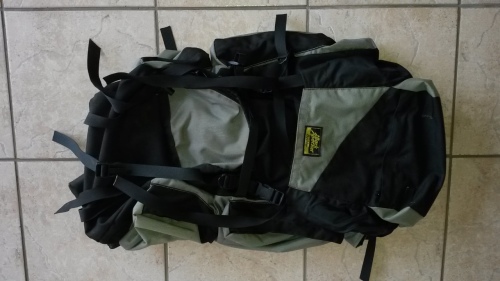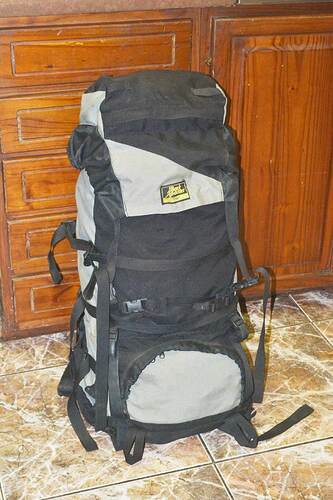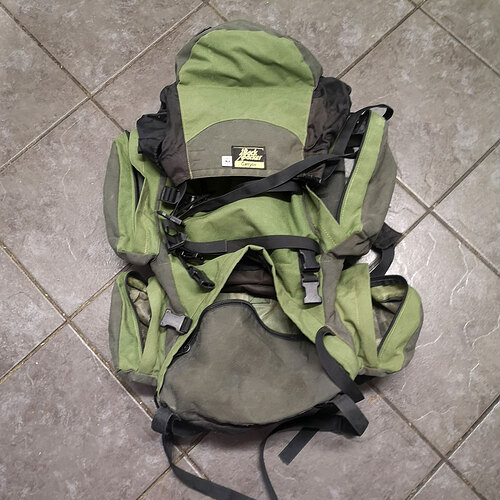I am thinking of getting a Backpacker pack but am unsure of the range of packs Backpacker made and the difference and features between models such as Elephant, Canyon, Boulder, Thar, etc., as well as the sizes available and weight of packs.
If anyone would be willing to give me some advice on the models, differences, sizes, and specs it
would be much appreciated ![]() .
.
Also does Backpacker still exist, or has the company been liquidated?
I think Blackpacker died while SA was still under apartheid.
Here is my limitted overview (to be corrected). Backpacker closed down in the 90’s, sadly, still operating in USA.
I had a Backpacker Elephant and a Boulder Rucksacks, best bags ever. The review and picks below is what I found to explain the differences. Starting with the biggest one.
- The Backpacker Thar 110 liter can extend to 130 liter to top pouch. This was the Royal bus used for Mountain Expeditions. It had the top pocket, but no side pockets for stability reasons. You were able to buy lose attachable pockets to strap on.
- The Backpacker Elephant 85 liter plus 15 liter top bag extended. (although specs indicate you can add up to 110 liter). I once had to fit two peoples gear, the boulder’s kit into mine after an injury. Great for long hikes.
- Backpacker Boulder 75 plus 10, and the Boulder 65 plus 10. The later the bottom two bags removed (early models). Great for normal long hikes 5 to 7 days.
- Backpacker Canyon 60 liter. Ideal for weekend short hikes.
- The baby, the Backpacker Super Scout 50/55 liter. Ideal for young people starting off.
Hope this helps.


In terms of weight, they average about 3kg, the bigger bags a bit more. The babys super light. They are on the heavier side comparing to Osprey, or First Accent, but competed with the Carrimore backpack range. The bags were made from Cordura ripstop waterproof fabric, and are extremely strong. Yet to find someone that said a backpacker ripped or came lose.
Here is a great overview on this forum:
Serious question, but why would someone need such a large backpack in this day and age?
My “big” pack is a Exos 58 and is often mostly empty while still carrying tent, sleeping system, stove, food clothes etc.
I’m probably going to go for a 40L next for 2-3 day hikes.
Calypso, with all due respect.
I know most people will wonder why large backpacks are needed, or necessary. I have found that once you start doing expeditions in uncharted areas where it is not a convenient A-rated commercialised clear path with cabin sleepovers, you will realise that a different set of clothes for example is used, being more bulky and heavier. Also, pending on time of year in colder areas, not all of us can afford e.g. expensive R2K+ puff jackets that can squeze dowb to a minimum. When hiking, trekking in mountain rough terrain areas for long period of time as in 7 to 10 days, you also carry much more food with you, including extra gas for oven, as well as other tools that may be needed in emergencies. (By the way, I use esbit fuel tabs to save space and weight). When camping in wild territory, you will also need additional first-aid kit etc, which also take up space as well. Some people prefer to take camera equipment, binoculars etc. Then you need power banks for recharging phone, or your navigation system if you dont use a map etc. You need extra camping lights. And not all backpacks has the capacity to strap the tent and mattras underneath, like on the old Aluminium external fram packs (still the best).
Your Osprey is a very expensive, and very good R5K+ bag, and very few people can afford such a kit. The question about the Backpackers revolve around affordability, while not compromising on strength, weight, and quality. The Backpackers were excellent value (and still is), better than any other entry level rucksack that went for the same price range. There is a few other older packs made that are still floating around.
In terms of sizes - I doubt very much if you will fit all the kit you will need for a solo trip with tent inside (if not strapped on outside), mattrass, groundsheet, ponchu, and extra clothes etc., for seven days in a smaller pack than 60 liter. The person posting the threat inquired about the older bags that was available, and are currently sold, mostly the 2nd hand market. He is still weighing his options.
The Backpackers and Carrimors have proven their trustworthiness over time. When you see how many Ospreys, K-way and First Accent backpacks are sold on hiking gear groups - it makes you think twice.
Never done a 7-day hike. So far it’s been 3 days max. But plenty over nighters. Gotten away with my 20l daypack for that.
7 day or more hikes are pretty rare for most whereas the shorter ones come up more often. I just generally find people like to pack their fears and fill all the available space they have.
While you may say that Osprey is expensive, it does come with a lifetime warranty. For many, that’s worth paying the extra price.
But hey, do what works for you.
I own a number of Backpacker back packs-they were the bags that were available in the 1980 and 90 and together with Carrimor, was the best available to us normal people in SA unless you could bring them in from overseas. They were bombproof and I still have and use my Boulder 65l that I bought in 1988 for my Drakensberg hikes.
On the question of size - well in my opinion it all depends on personal preference. As a guide I find that I have to have a few extras like a full first aid kit - a rope for some trips and other extras. In the end not every one can afford the new light weight gear and the more “normal” gear are a bit bulkier and heavier. Most people cannot afford the light weight gear due to cost or availability and I can see that most ordinary people still use the more affordable but bulkier and also heavier gear for hiking.
For most of my trips I use my Osprey 70l and some times it full to the brim other times not. I have also upgraded to a 80l Osprey so my winter gear can fit - mainly my winter sleeping bag that’s a bit bigger than my normal 3 season bag.
And I know people say that the Backpackers are heavy - but that made them bomb proof - remember most of them were made before most of the newer materials were available and in my opinion they were way ahead of their time for what were available in SA at the time - if not the world.
Thanks Deon, I was beginning to think that I’m the only Backpacker rucksack fan. Still think they better than Osprey’s, for a number of reasons. Just my own view.
Yes old technology by bomb proof.
They are great bags if you can get them!
They were still around in Pretoria in 2017, I chatted to the owner’s son who was pushing to revive the brand, don’t know about now though.
I bought a grey Boulder in 1990 - many berg hikes, hunting, fishing and climbing weekends later - I still use it as my primary bag. Iv had modern packs that lasted 2 - 3 hikes then broke, so i’m not convinced about the modern expensive super light (single use) stuff, and I LOVE the side pockets and all the external straps, makes life so much easier!
Im still looking for an old Elephant Backpacker. Hope someone has one that they want to pass-on. Mine was unfortunately stolen some time ago.
I have a Backpacker Badger 65 which I used to do some SA overnight hikes but only ever for hikes over 2 nights, the Fish River Canyon and one in the Berg. It’s been safely packed away and looked after since then and is in excellent condition. Now I’m busy decluttering, does anyone on the forum have any idea what price I should put on a Badger to sell it on to someone who would appreciate it?
Micatyro. The Backpacker bags has not got much resale value on the marjket anymore and on Facebook you can get the Canyons or Boulder easily for less than R500. The bags has sentimental value for those who are familiar with them and normally is sold to someone who loves the bags. This being that the trend is lightweight gear and modern ergonomics, hence the new expensive packs on the market. However for a beginner or casual hikers, they should grab a backpacker bag when available and keep it. I still use my Thar and Boulder, Would love to get my larger capacity Elephant back, if anybody got one needing a home.


